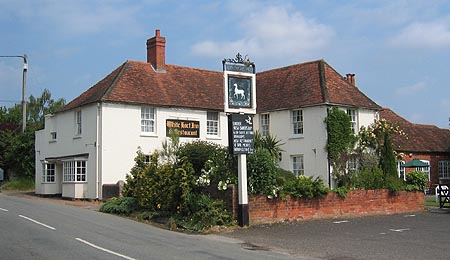 |
 |
|||
|
|
 Hamstead
Marshall Hamstead
MarshallEarls & Industrial Uproar This place-name is simple to explain. The prefix means "homestead", just like it sounds. This early settlement - now a deserted medieval village visible as bumps in the ground - was centred around where the parish church was built in the 12th century. Within Hamstead Park stand three, much eroded, castle mottes. One of the two near the church is the earliest, possibly set up by Hugelin the Steersman who held the manor at Domesday (1086). Its sibling seems to be an updated replacement. They were both homes of the celebrated Marshal family who gave the place-name its suffix. John Marshal is recorded in John d'Earley's biographically poem, the 'History of William the Marshal' as having held 'Newbury Castle' - probably one of those at Hamstead - as early as 1253. He was besieged there by King Stephen for two months during his Civil War with the Empress Matilda. The fortification near the old manor fishponds (which were stocked with Royal bream as early as 1230) was probably the King’s siege castle. Most of the village must have been overrun by Royal rabble-rousing forces, until Marshal gave up William, his eldest son, as a hostage to ensure his future good behaviour. The young lad grew up to become both Earl of Pembroke and Protector of England. He had many manors, Pembroke Castle was probably the most significant, Caversham Castle was another, but Hamstead was his principal residence in the South of England. Nestling in the Kennet Valley, a mere horse-ride from the Royal Court in Windsor or London, the estate soon became attached to his father’s old position of Marshal of England. William entertained King Henry III at Hamstead in 1218. His brother, Gilbert, replaced the castle with a new one in the 1230s. This was in Royal hands by the 14th century and Edward III liked to stay there for Christmas in the 1350s. He was probably on hunting expeditions: the park had been stocked with deer a hundred years earlier. In Tudor times, the manor was in the hands of Sir Thomas Parry and his son, loyal servants of Queen Elizabeth I who is said to have come here under mysterious circumstances. They built a fine mansion in the park - the dovecote of which appears to be the basis of the present Morewood House - but this was soon to be replaced by the palace of the Earls of Craven. Until very recently, the Cravens still lived at Hamstead. They had done so since the 1660s. The First Earl was the devoted follower of Charles I’s sister, Elizabeth, the Winter Queen of Bohemia. She was the impoverished widow of the Elector of the Palatinate who, being elected King of Bohemia, was only able to take up his throne for one winter before opposing forces pushed him out. Lord Craven apparently fell in love with the lady (some say he secretly married her). He put his vast fortune at her disposal and built her a glorious palace in Hamstead Park, supposedly inspired by Heidelberg Castle (though it looked nothing like it). Sadly she died before the mansion was finished. The Cravens lived there for sixty years before it burnt to the ground in1718. Only some rather elaborate gateposts remain. They then moved into the keeper’s house, Hamstead Lodge. During the Agricultural Revolution of the early 19th century, Berkshire was the centre of much unrest from disgruntled farmworkers who were being replaced by machinery. The ‘Swing’ or ‘Kintbury Riots’ of 1830 spilled into Hamstead in November of that year when the rioters stopped for a drink at the Craven Arms before marching on the Park and demanding money from Lord Craven. His Lordship was ready to see them off by force but was persuaded by the vicar to give in. The next day, however, he had his revenge by leading the mounted constables in rounding up the miscreants in Kintbury. Many were transported and some condemned to death.
|
|||
| © Nash Ford Publishing 2004. All Rights Reserved. | ||||


